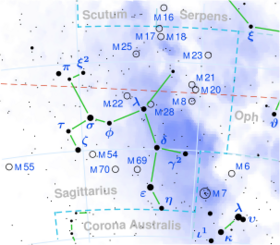Astronomy:X Sagittarii
| Observation data Equinox J2000.0]] (ICRS) | |
|---|---|
| Constellation | Sagittarius |
| Right ascension | 17h 47m 33.62410s[1] |
| Declination | −27° 49′ 50.8490″[1] |
| Apparent magnitude (V) | 4.54[2] |
| Characteristics | |
| Spectral type | F7II[3] |
| U−B color index | +0.50[2] |
| B−V color index | +0.80[2] |
| Variable type | Cepheid[4] |
| Astrometry | |
| Radial velocity (Rv) | −10.10[5] km/s |
| Proper motion (μ) | RA: −5.097[1] mas/yr Dec.: −9.722[1] mas/yr |
| Parallax (π) | 3.4314 ± 0.2020[1] mas |
| Distance | 950 ± 60 ly (290 ± 20 pc) |
| Absolute magnitude (MV) | −2.85[6] |
| Details | |
| Mass | 6.31[7] M☉ |
| Radius | 53±3[8] R☉ |
| Luminosity | 2,647[7] L☉ |
| Surface gravity (log g) | 1.77[9] cgs |
| Temperature | 6,305[7] K |
| Metallicity [Fe/H] | −0.01[6] dex |
| Rotational velocity (v sin i) | 27.1[10] km/s |
| Other designations | |
| Database references | |
| SIMBAD | data |
X Sagittarii is a variable star and candidate binary star system in the southern constellation of Sagittarius, near the western constellation boundary with Ophiuchus. It has a yellow-white hue and is visible to the naked eye with an apparent visual magnitude that fluctuates around 4.54.[2] The star is located at a distance of approximately 950 light years from the Sun based on parallax,[1] and is drifting closer with a radial velocity of −10 km/s.[5] The star has an absolute magnitude of around −2.85.[6]

This is an F-type bright giant with a stellar classification of F7II.[3] It is a Classical Cepheid variable that ranges in apparent magnitude from 4.20 down to 4.90 with a period of 7.01283 days.[13] Its variation in brightness is accompanied by a change in spectral classification, from G2 to F5.[4] The amplitude of each pulsation causes the stellar radius to vary by ~9%.[14] Analysis of the spectra suggest there are two shock waves per pulsation period, with complicated patterns appearing in the metallic lines.[15] The star is surrounded by an optically-thin circumstellar envelope at 15–20 stellar radii, which appears as an infrared excess of 13.3%.[16] This may be composed of amorphous carbon.[14]
László Szabados suggested in 1990 that this might be a binary system with a period of 507 days. A detection of this projected companion was reported in 2013 using the VLTI/AMBER instrument. However, the object was at the detection limit of the instrument, showing an angular separation of 10.7 mas from the primary and a magnitude difference of 5.6 in the K-band.[8] A subsequent optical search reported a failure to detect the companion in 2014, excluding companions brighter than a A-type main-sequence star class of A9V.[17] The estimated mass of this object is 0.2–0.3 M☉.[15]
References
- ↑ 1.0 1.1 1.2 1.3 1.4 1.5 Brown, A. G. A. (August 2018). "Gaia Data Release 2: Summary of the contents and survey properties". Astronomy & Astrophysics 616: A1. doi:10.1051/0004-6361/201833051. Bibcode: 2018A&A...616A...1G. Gaia DR2 record for this source at VizieR.
- ↑ 2.0 2.1 2.2 2.3 Ducati, J. R. (2002). "Catalogue of Stellar Photometry in Johnson's 11-color system". CDS/ADC Collection of Electronic Catalogues 2237. Bibcode: 2002yCat.2237....0D.
- ↑ 3.0 3.1 Houk, Nancy (1979), Michigan catalogue of two-dimensional spectral types for the HD stars, 3, Ann Arbor, Michigan: Dept. of Astronomy, University of Michigan, Bibcode: 1982mcts.book.....H
- ↑ 4.0 4.1 Samus, N. N. et al. (2009). "General Catalogue of Variable Stars (Samus+ 2007-2013)". VizieR On-line Data Catalog: B/GCVS. Originally Published in: 2009yCat....102025S 1. Bibcode: 2009yCat....102025S.
- ↑ 5.0 5.1 Kharchenko, N. V. et al. (2007). "Astrophysical supplements to the ASCC-2.5: Ia. Radial velocities of ~55000 stars and mean radial velocities of 516 Galactic open clusters and associations". Astronomische Nachrichten 328 (9): 889. doi:10.1002/asna.200710776. Bibcode: 2007AN....328..889K.
- ↑ 6.0 6.1 6.2 Anderson, E.; Francis, Ch. (2012). "XHIP: An extended hipparcos compilation". Astronomy Letters 38 (5): 331. doi:10.1134/S1063773712050015. Bibcode: 2012AstL...38..331A. Vizier catalog entry
- ↑ 7.0 7.1 7.2 Hohle, M. M. et al. (2010). "Masses and luminosities of O- and B-type stars and red supergiants". Astronomische Nachrichten 331 (4): 349. doi:10.1002/asna.200911355. Bibcode: 2010AN....331..349H. Vizier catalog entry
- ↑ 8.0 8.1 Li Causi, G. et al. (January 2013). "On the binarity of the classical Cepheid X Sagittarii from interferometric observations". Astronomy & Astrophysics 549: 5. doi:10.1051/0004-6361/201220207. A64. Bibcode: 2013A&A...549A..64L.
- ↑ Soubiran, Caroline; Le Campion, Jean-François; Brouillet, Nathalie; Chemin, Laurent (2016). "The PASTEL catalogue: 2016 version". Astronomy & Astrophysics 591: A118. doi:10.1051/0004-6361/201628497. Bibcode: 2016A&A...591A.118S.
- ↑ De Medeiros, J. R.; Mayor, M. (1999). "A catalog of rotational and radial velocities for evolved stars". Astronomy and Astrophysics Supplement Series 139 (3): 433. doi:10.1051/aas:1999401. Bibcode: 1999A&AS..139..433D. Vizier catalog entry
- ↑ "X Sgr". SIMBAD. Centre de données astronomiques de Strasbourg. http://simbad.u-strasbg.fr/simbad/sim-basic?Ident=X+Sgr.
- ↑ "ASAS All Star Catalogue". The All Sky Automated Survey. http://www.astrouw.edu.pl/asas/?page=aasc.
- ↑ Samus, N. N. et al. (2017). "General Catalogue of Variable Stars". Astronomy Reports. 5.1 61 (1): 80–88. doi:10.1134/S1063772917010085. Bibcode: 2017ARep...61...80S.
- ↑ 14.0 14.1 Gallenne, A. et al. (February 2012). "Thermal infrared properties of classical and type II Cepheids. Diffraction limited 10 μm imaging with VLT/VISIR". Astronomy & Astrophysics 538: 16. doi:10.1051/0004-6361/201117307. A24. Bibcode: 2012A&A...538A..24G.
- ↑ 15.0 15.1 Mathias, P. et al. (October 2006). "Multiple shock waves in the atmosphere of the Cepheid X Sagittarii?". Astronomy and Astrophysics 457 (2): 575–579. doi:10.1051/0004-6361:20065299. Bibcode: 2006A&A...457..575M.
- ↑ Gallenne, A. et al. (October 2013). "Extended envelopes around Galactic Cepheids. IV. T Monocerotis and X Sagittarii from mid-infrared interferometry with VLTI/MIDI". Astronomy & Astrophysics 558: 9. doi:10.1051/0004-6361/201322257. A140. Bibcode: 2013A&A...558A.140G.
- ↑ Gallenne, A. et al. (July 2014). "Searching for visual companions of close Cepheids. VLT/NACO lucky imaging of Y Oph, FF Aql, X Sgr, W Sgr, and η Aql". Astronomy & Astrophysics 567: 8. doi:10.1051/0004-6361/201423872. A60. Bibcode: 2014A&A...567A..60G.
 |


